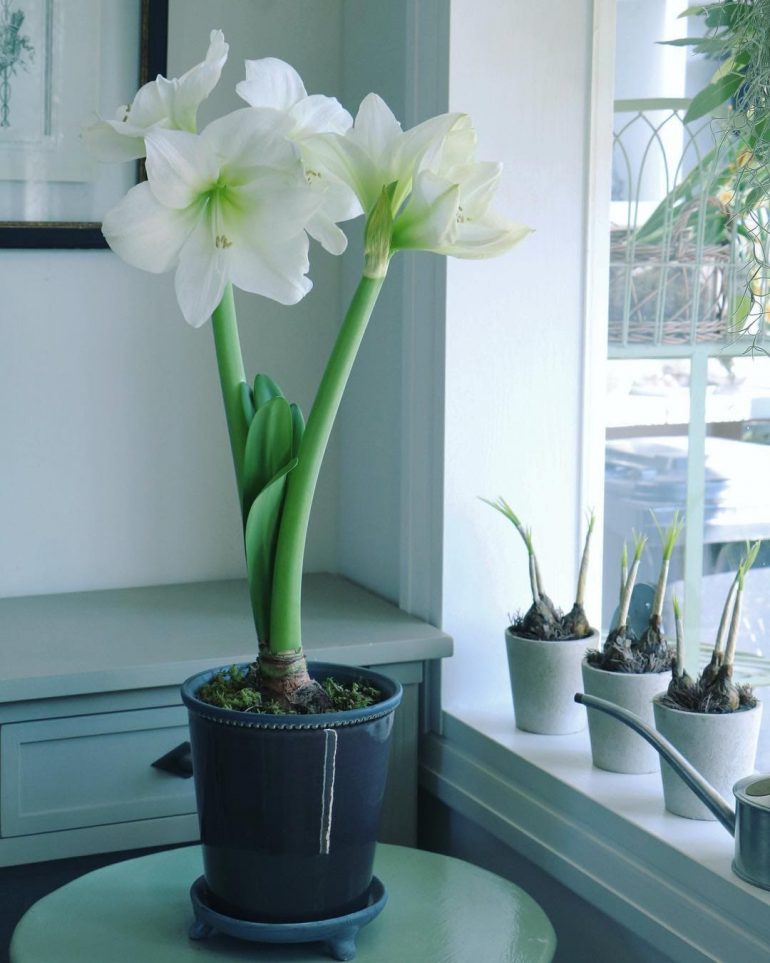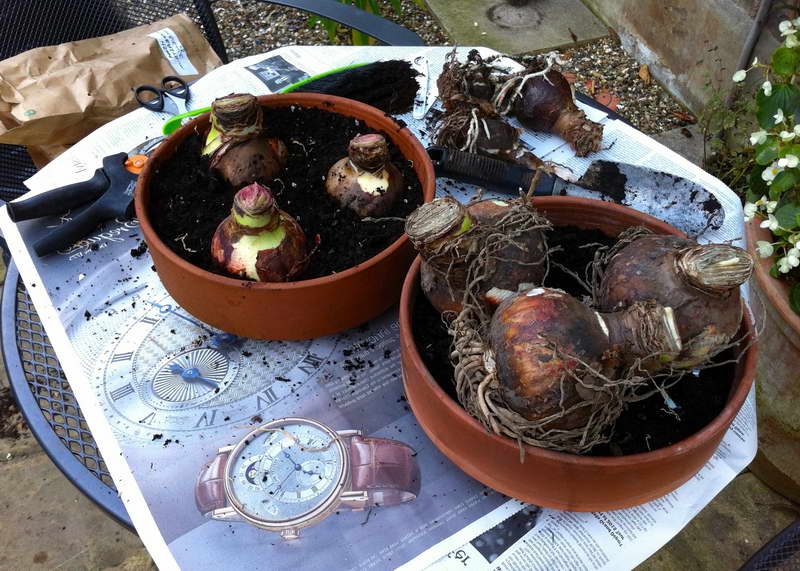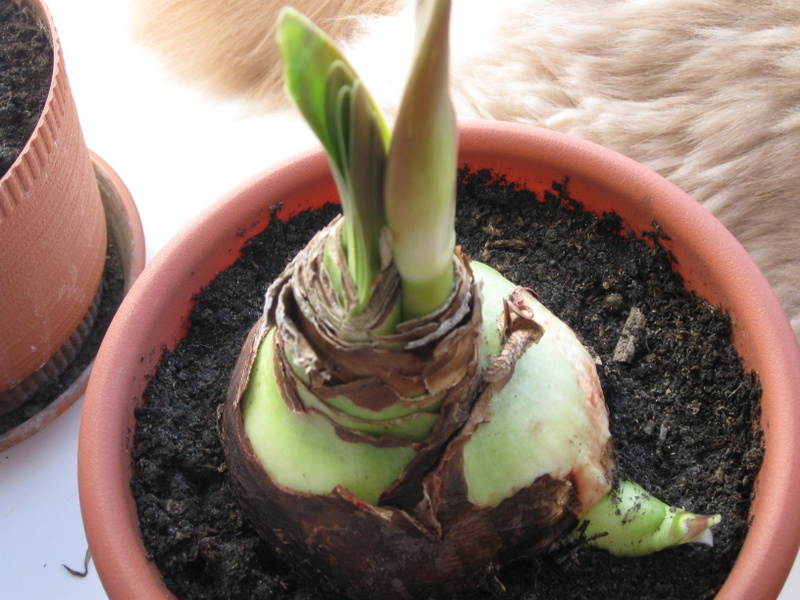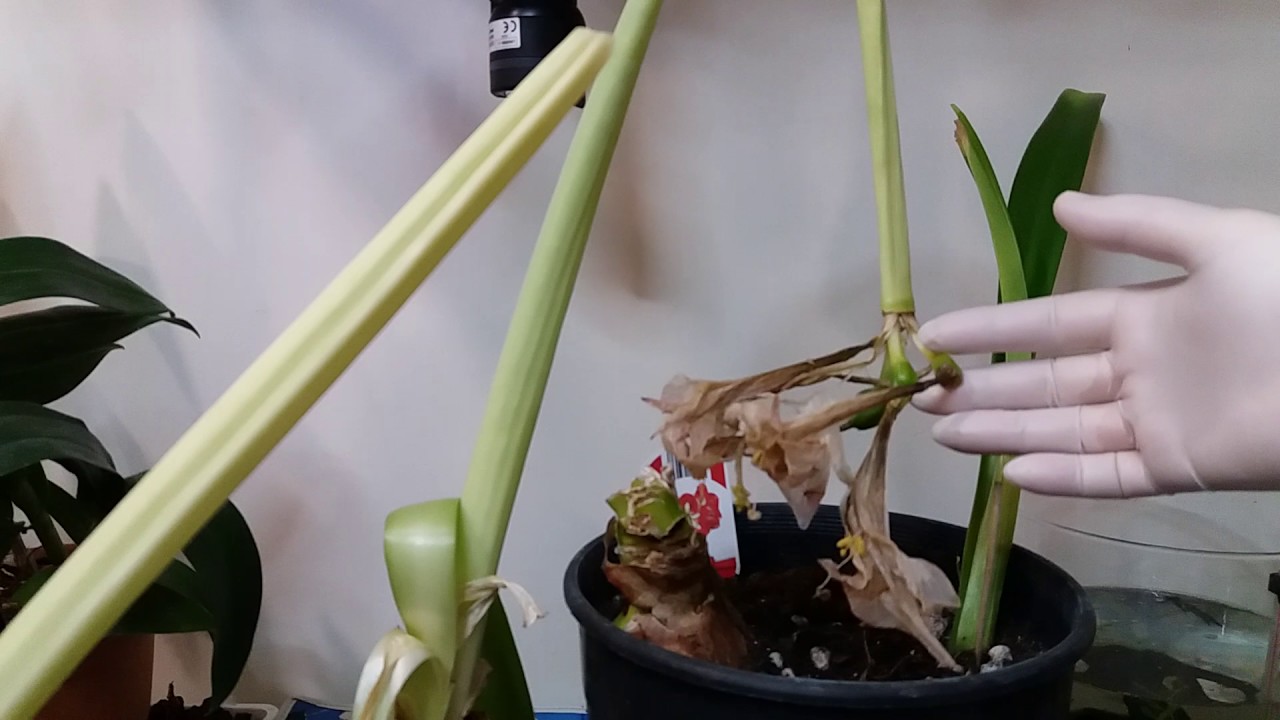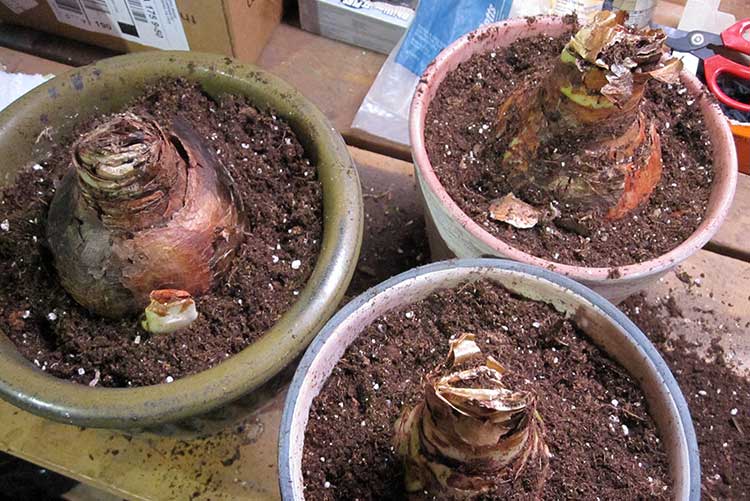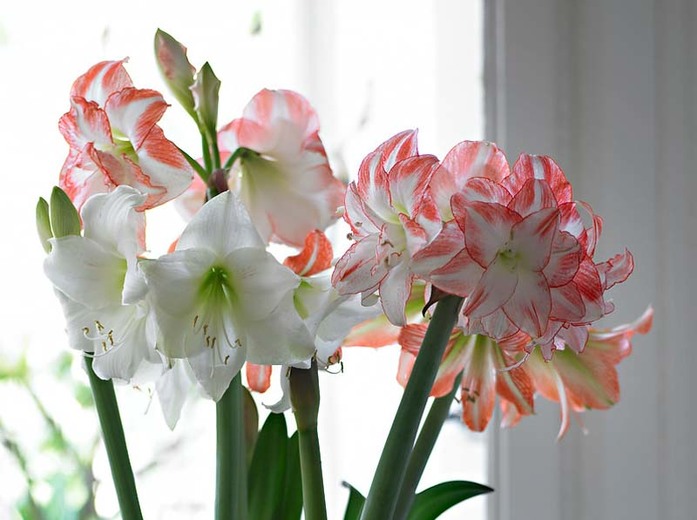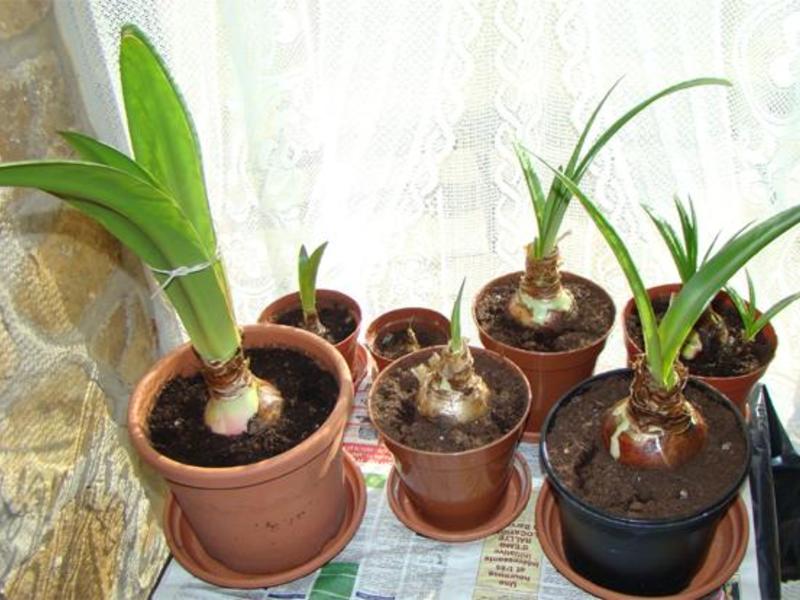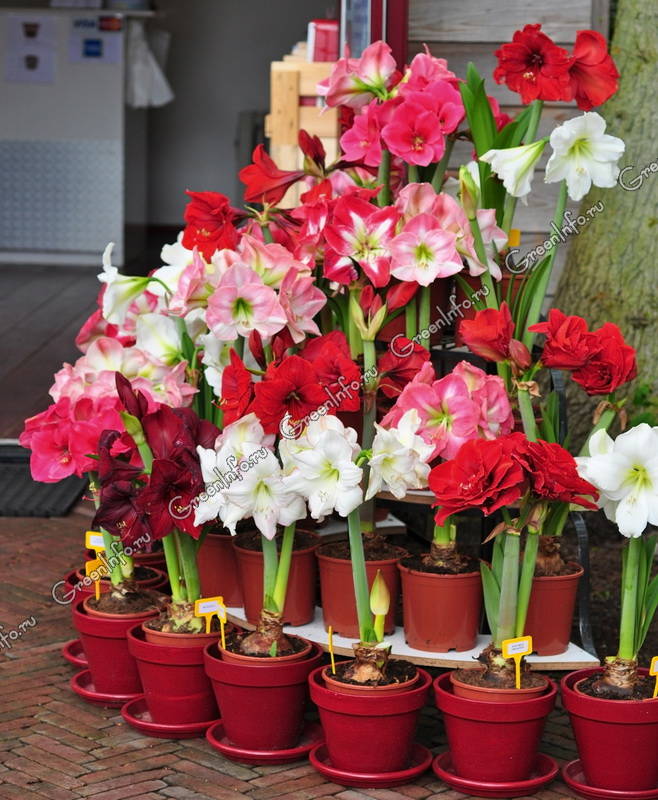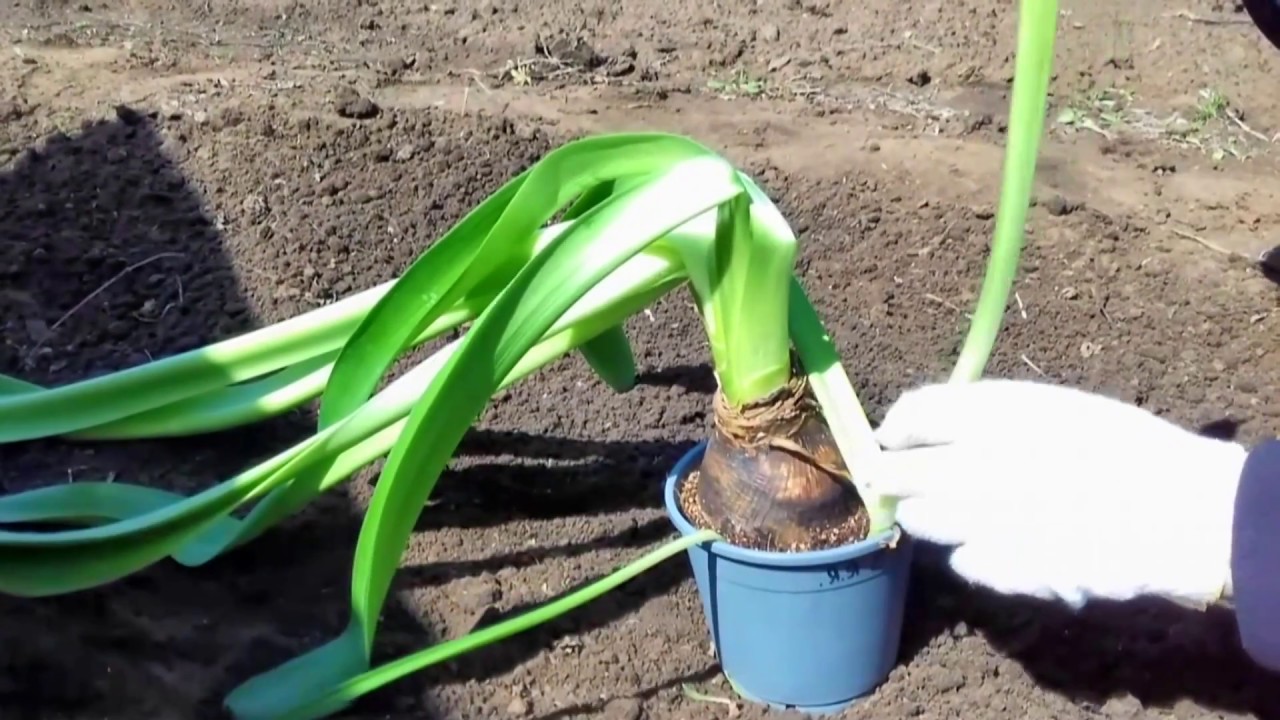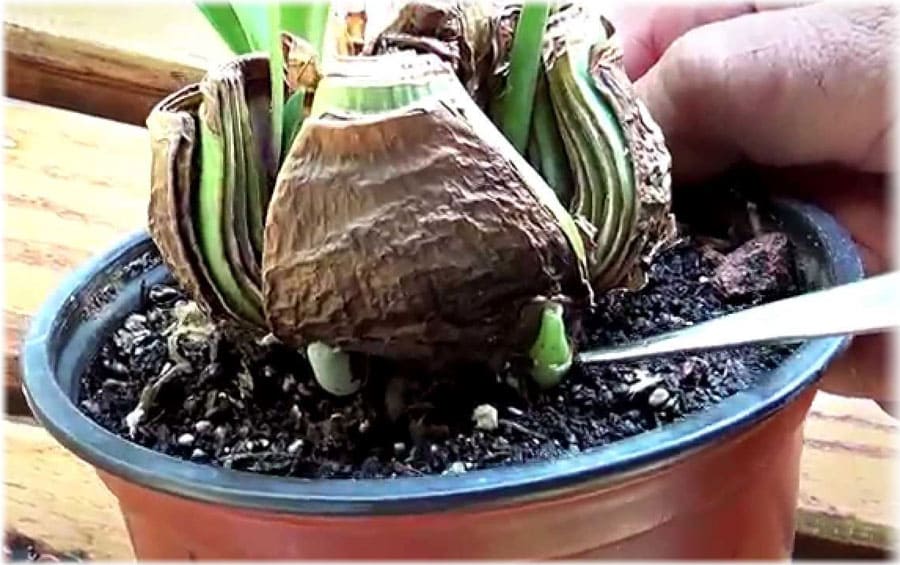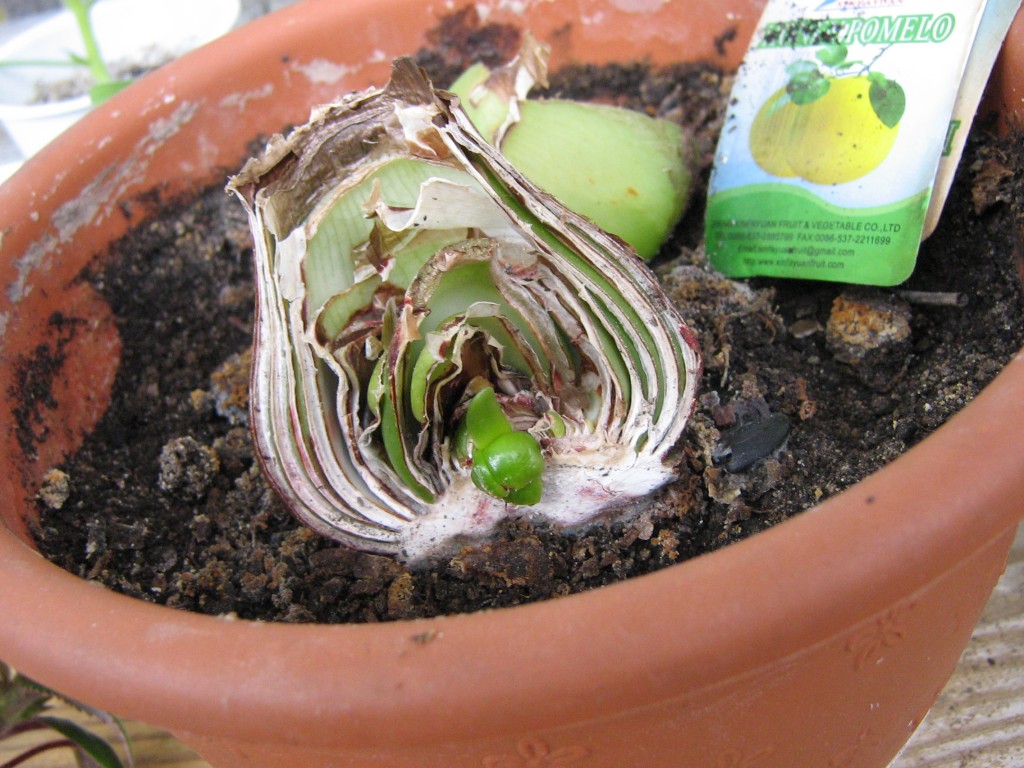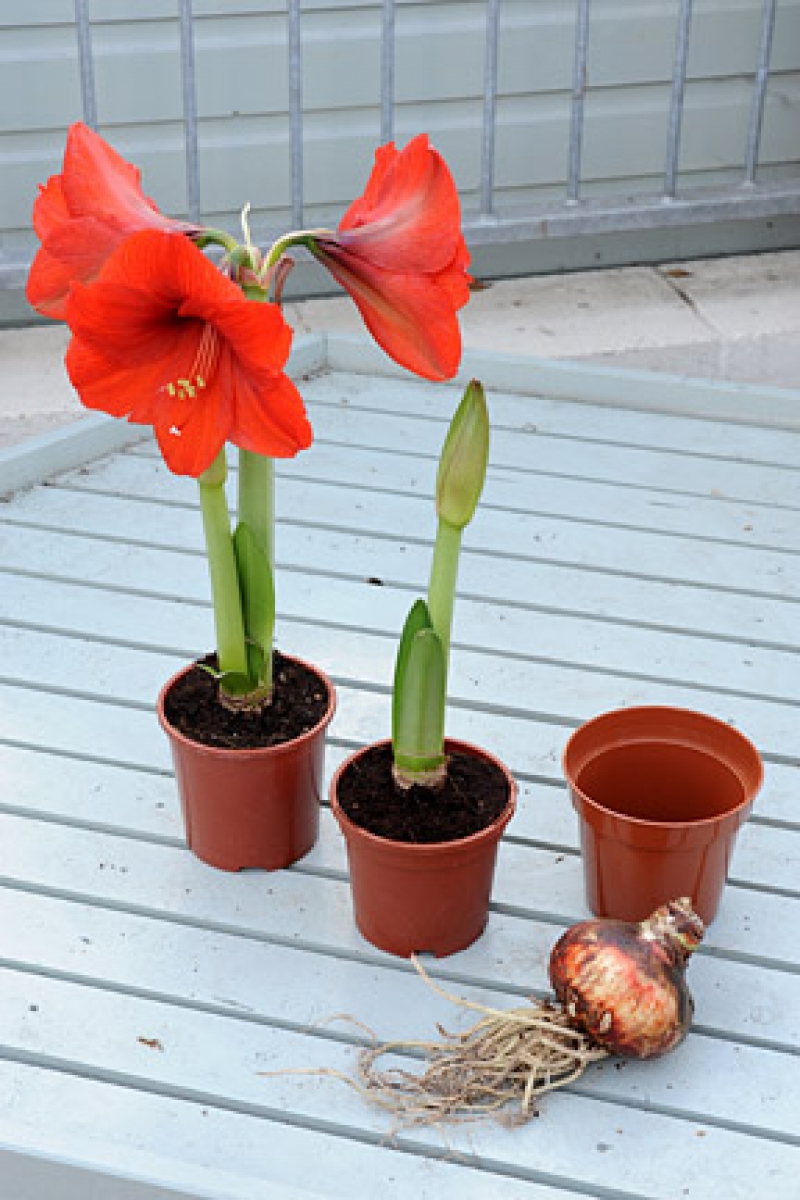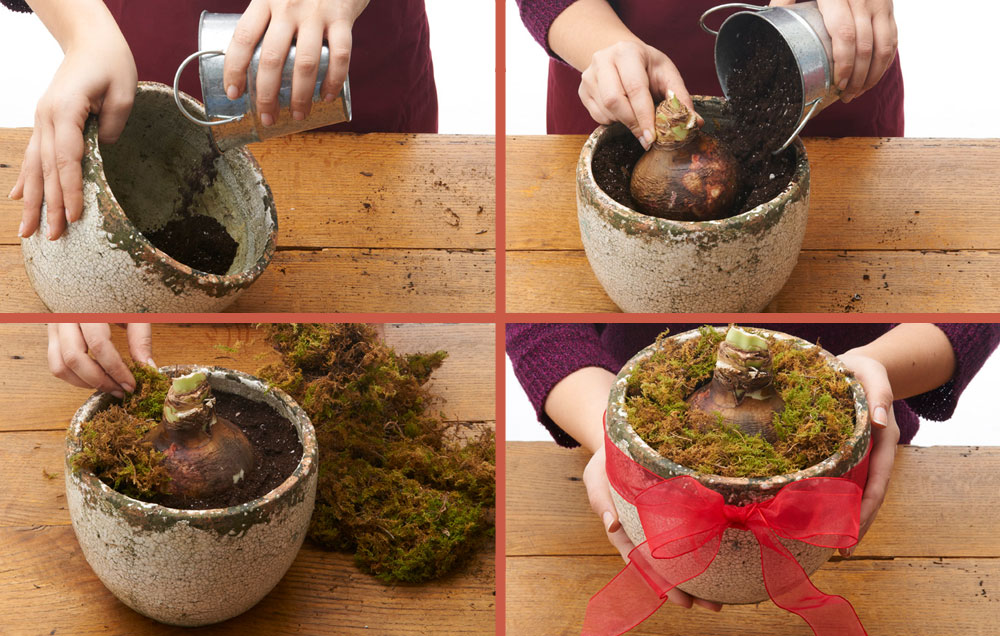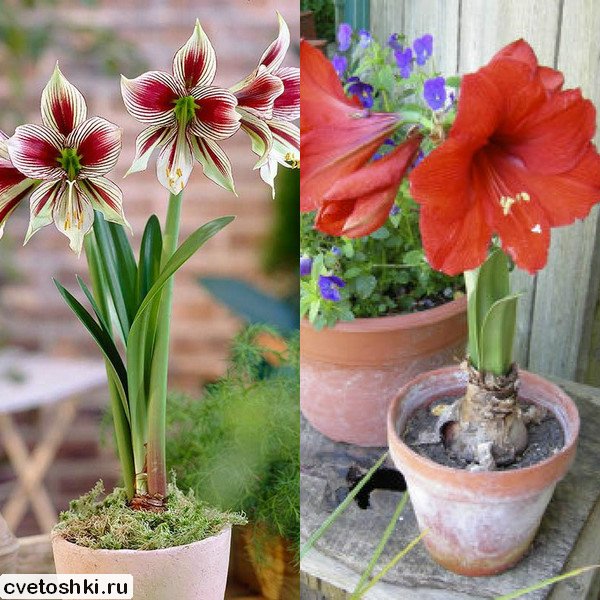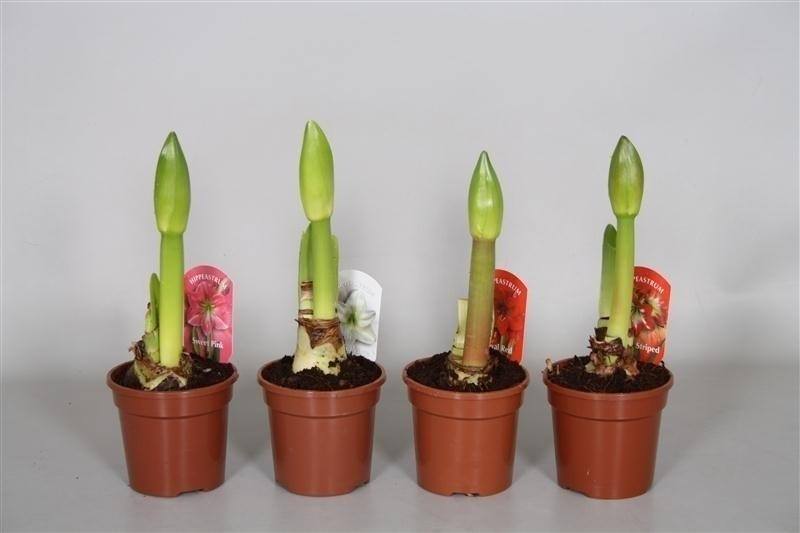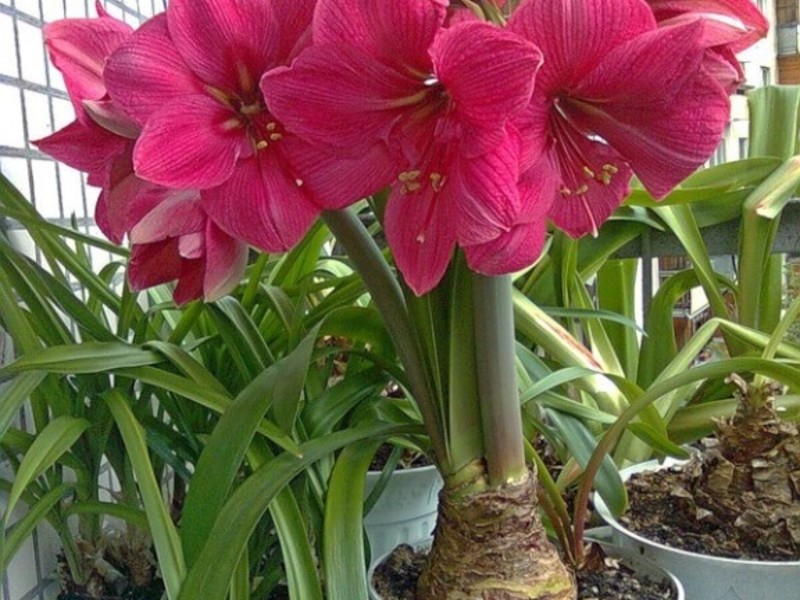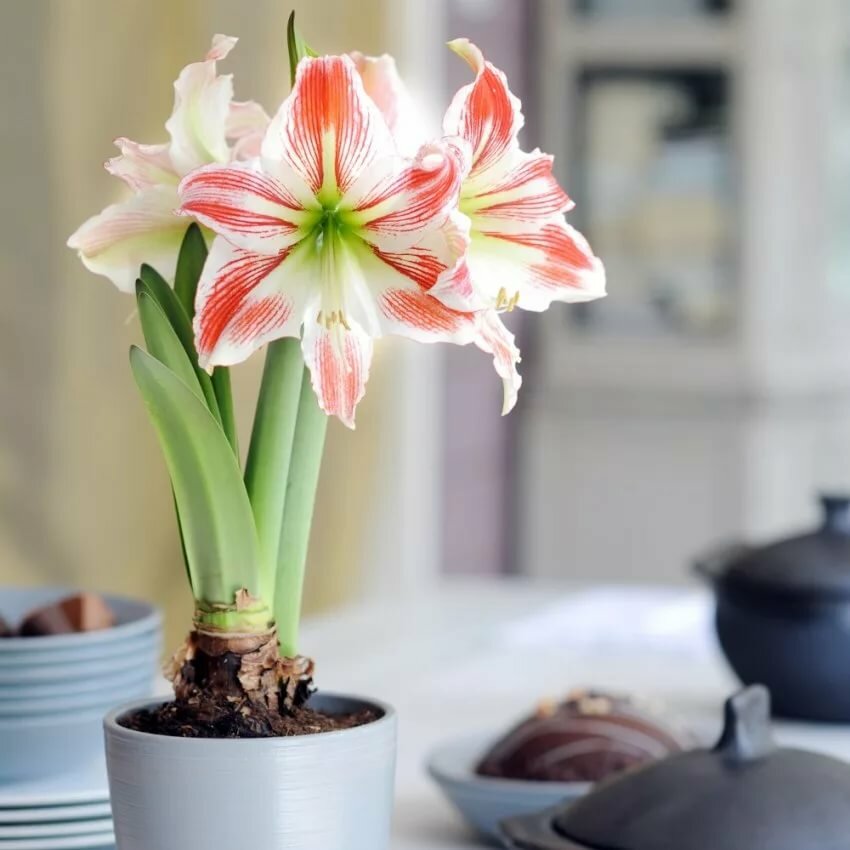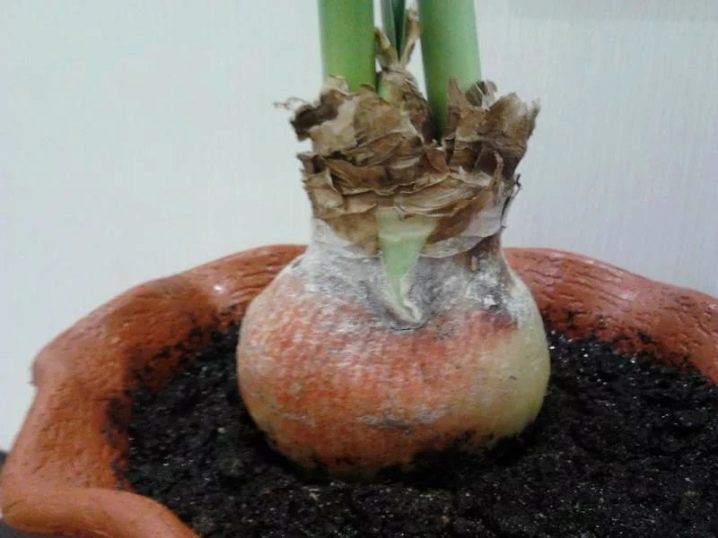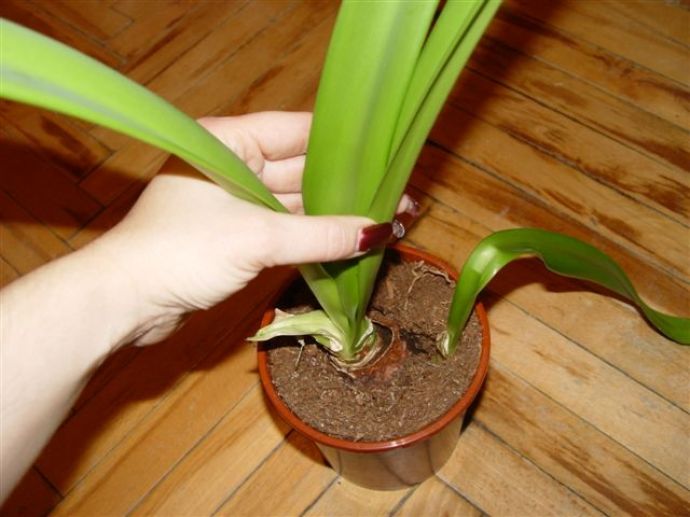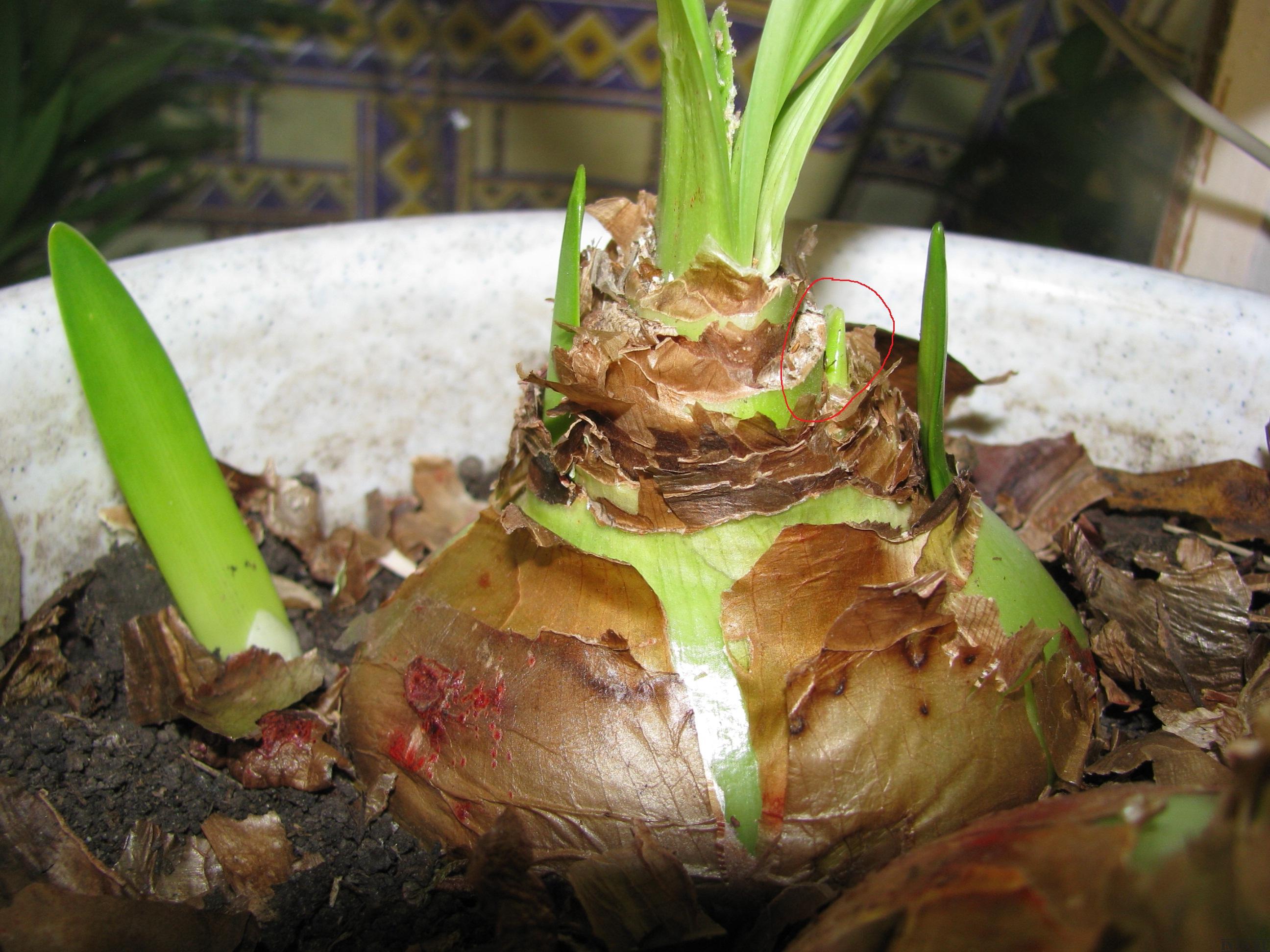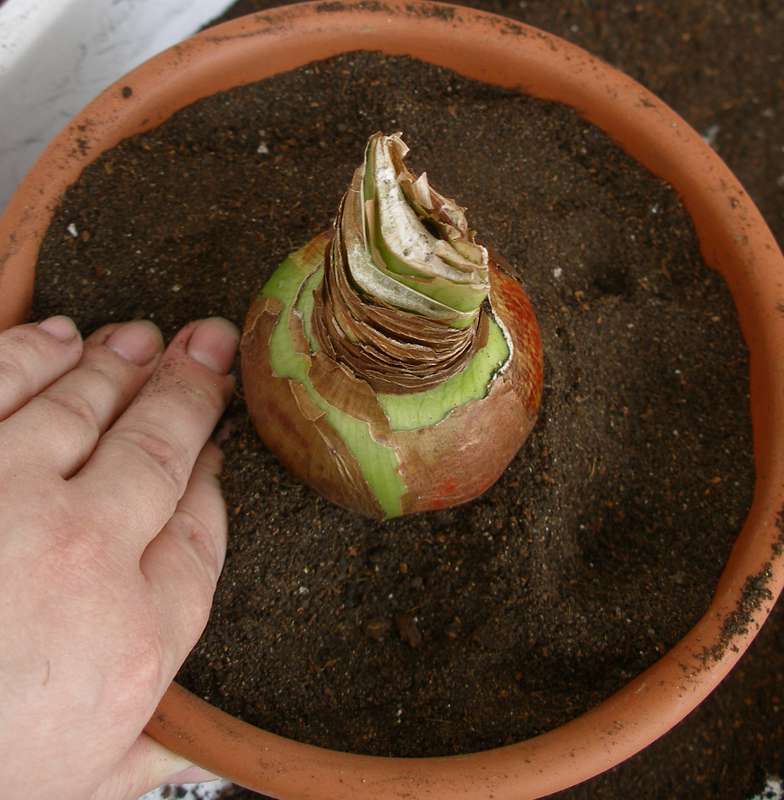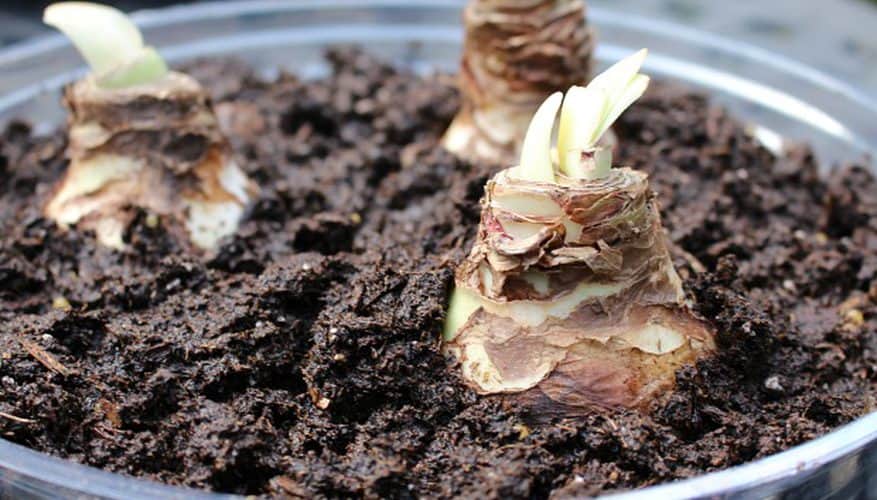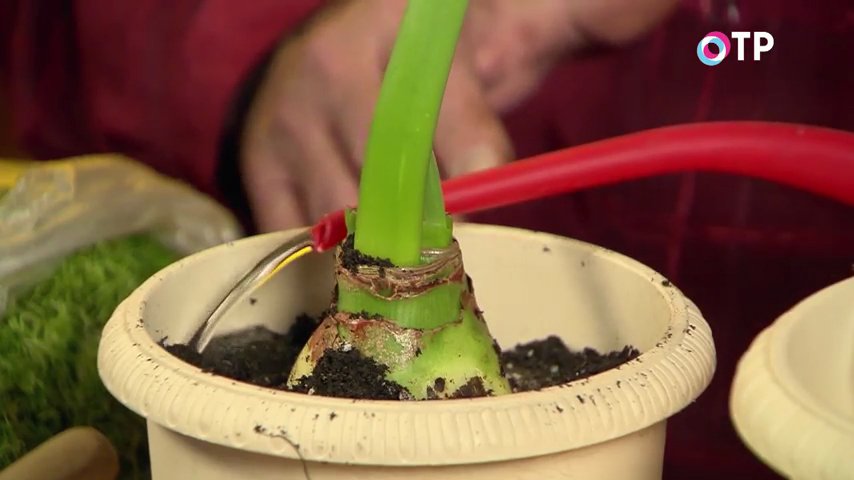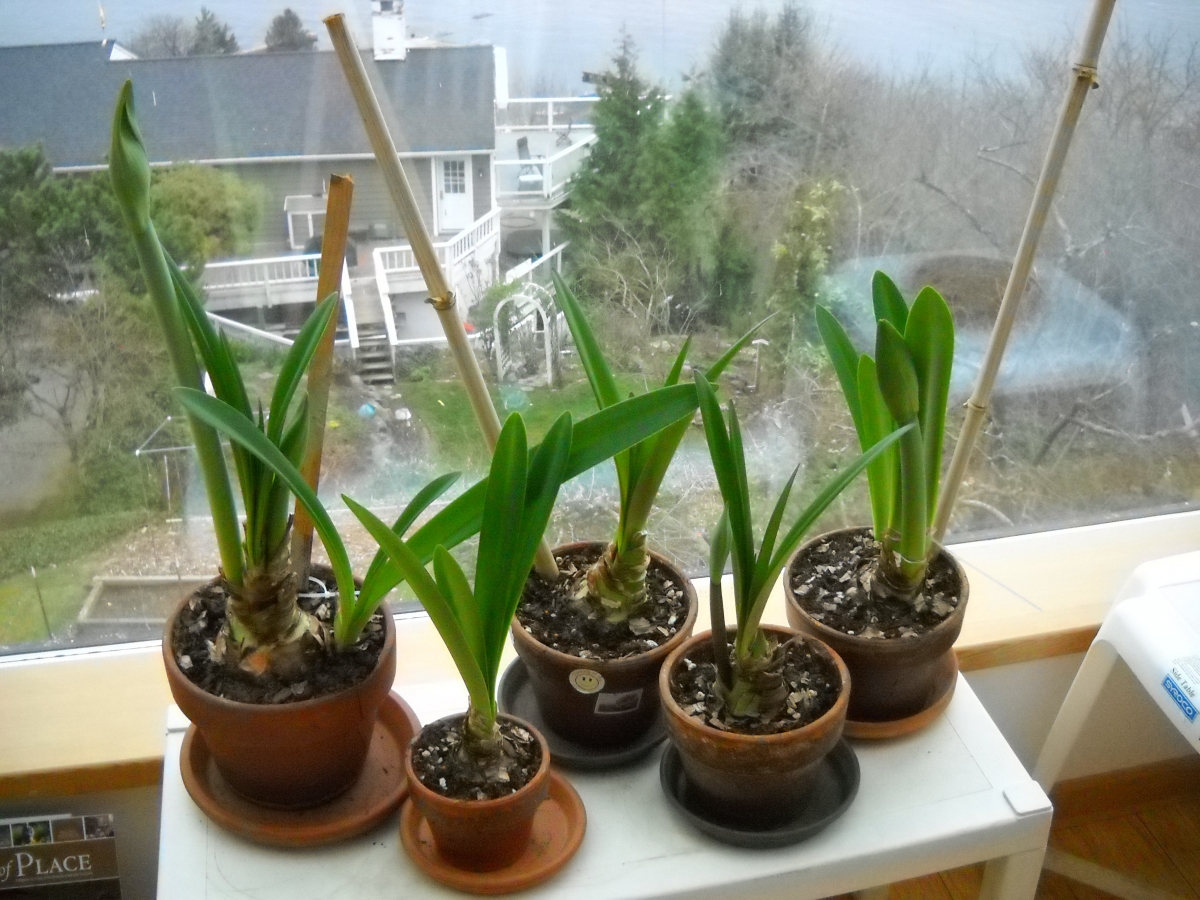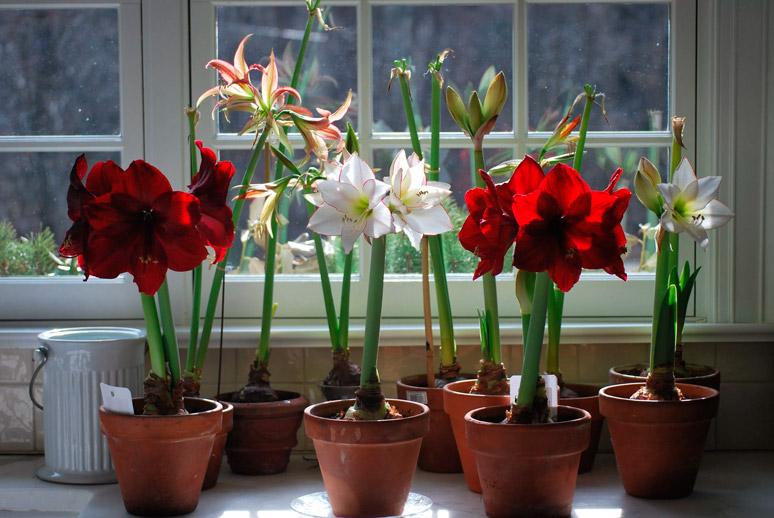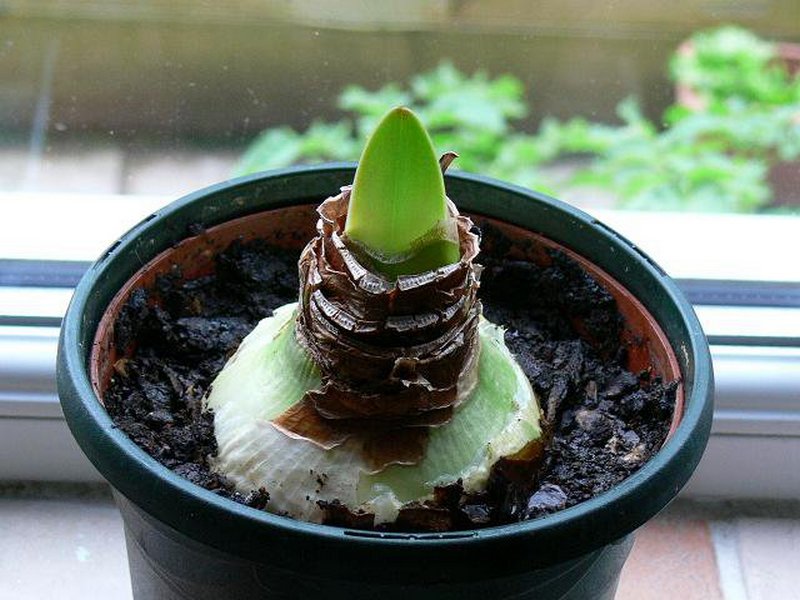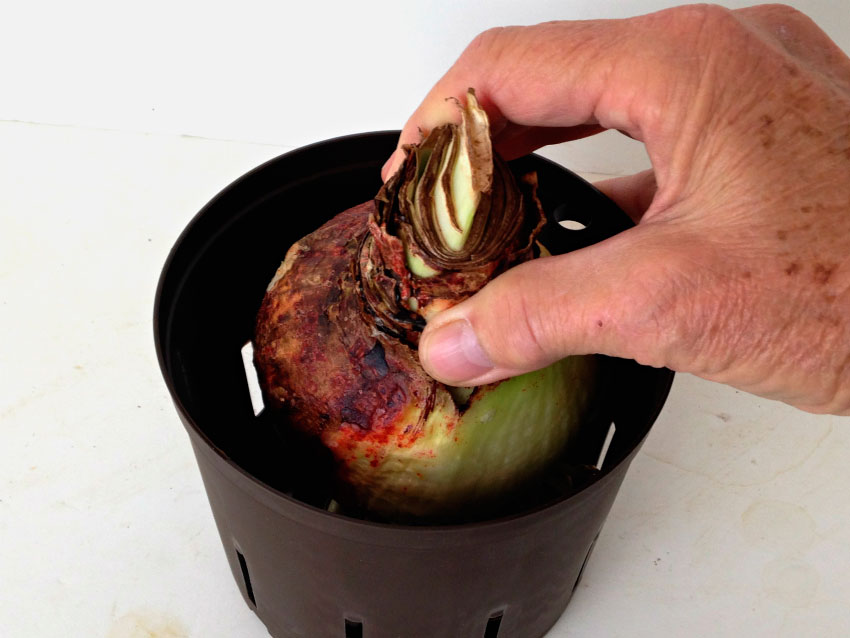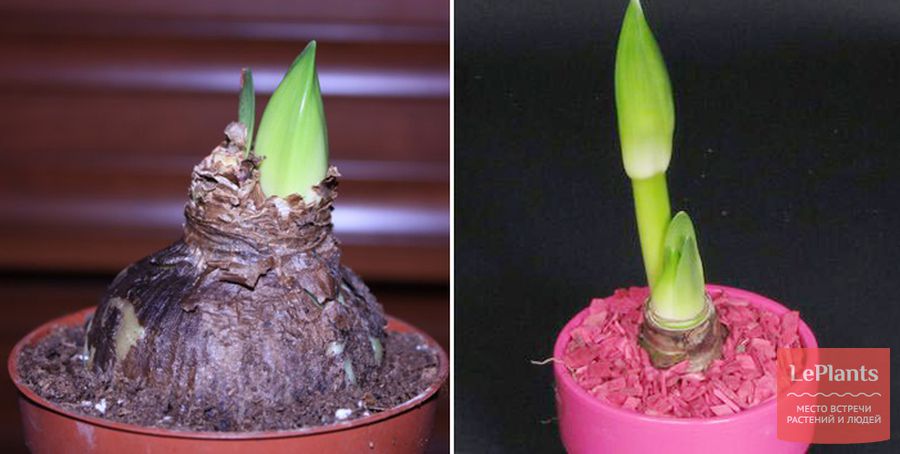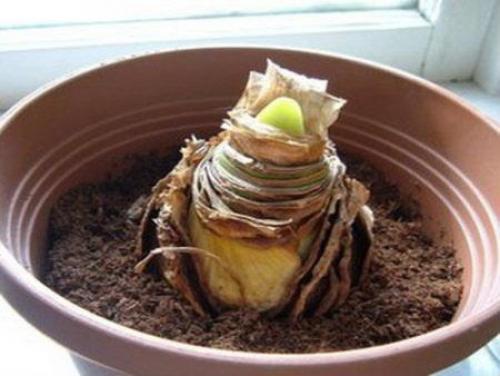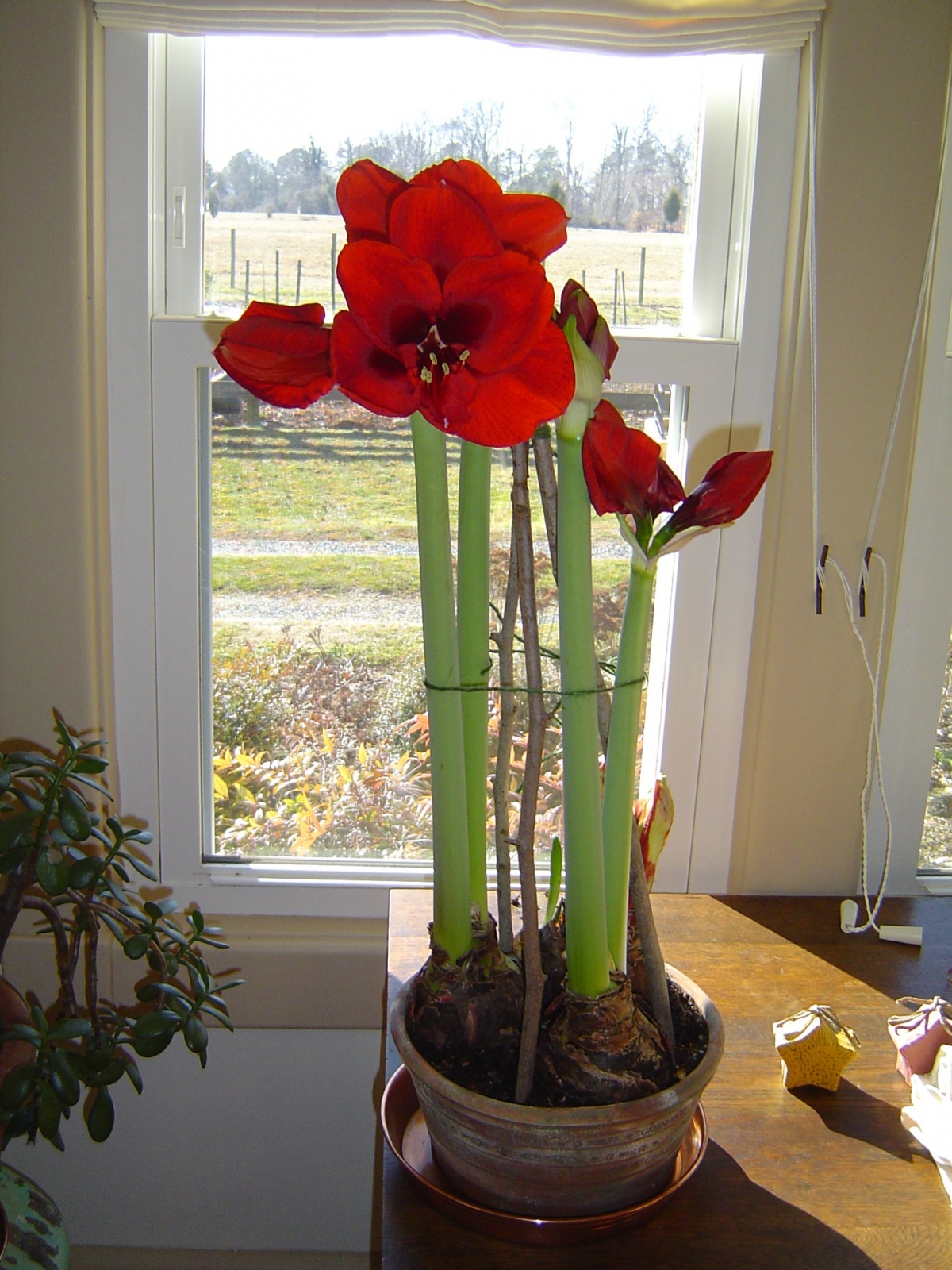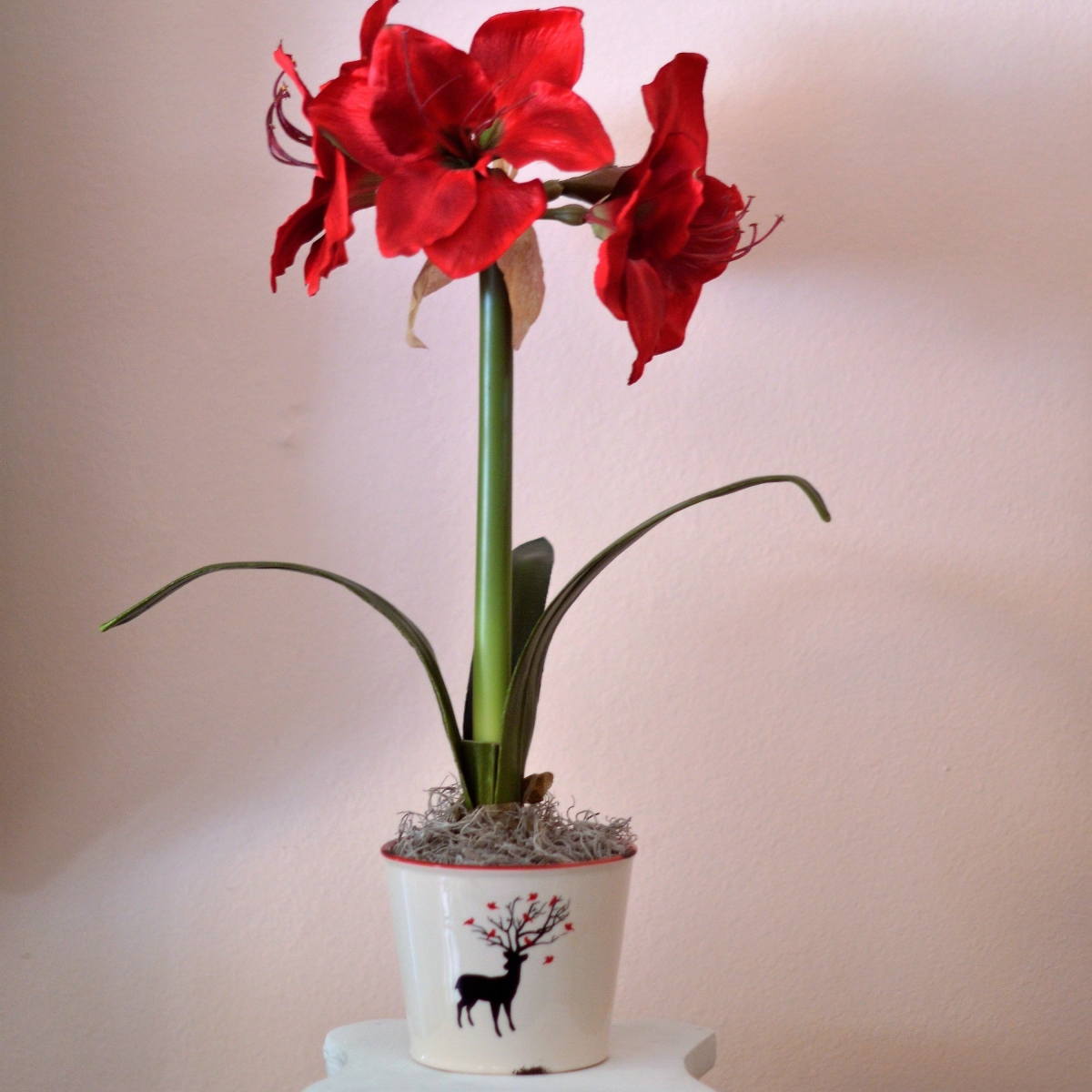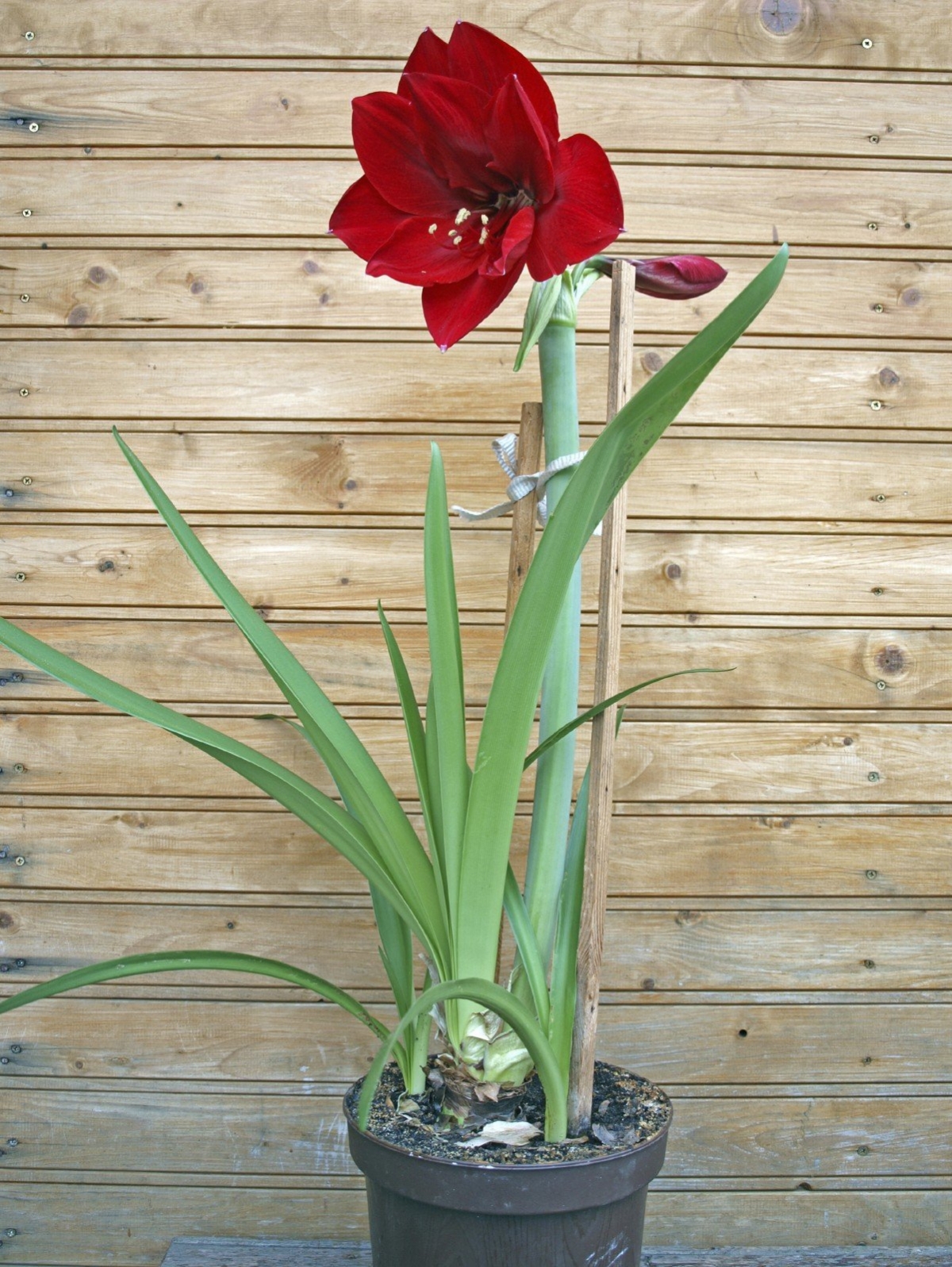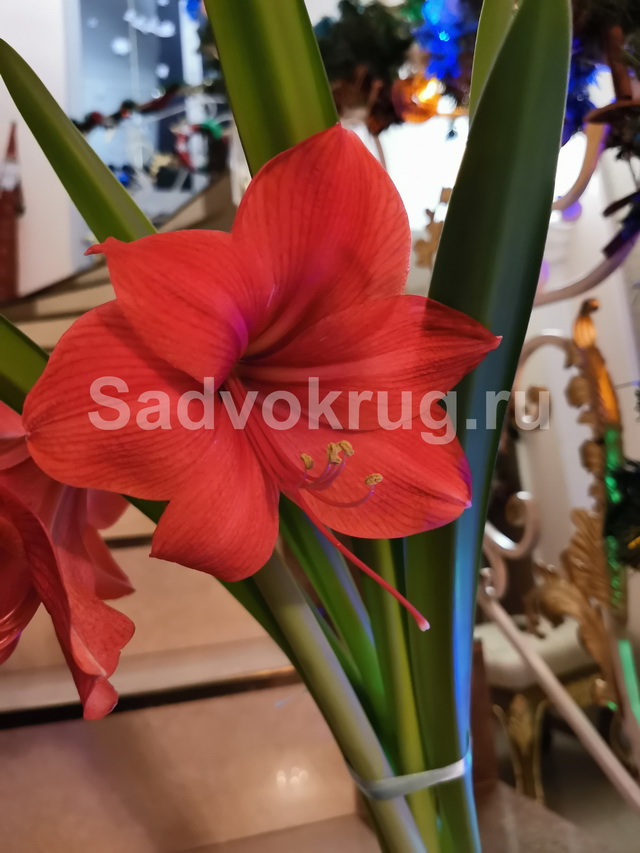Reproduction of amaryllis
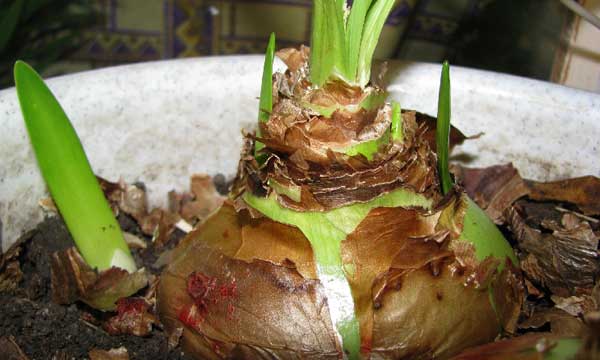
This flower can be propagated in two ways - by seeds and daughter bulbs.
Reproduction of amaryllis by seeds
This method is not particularly popular due to its unreliability and laboriousness. If you want to try this method, then preference should be given to seeds from your plant, and not purchased ones. Of course, if you have your own amaryllis. To obtain seeds, the flowers must be manually pollinated. This can be done with a soft brush, transferring pollen from flower to flower. After flowering, a seed box should form. When it is dry and cracked, you can harvest the seeds. They are planted in light nutritious soil, and grown like a normal seedling. The flowering of amaryllis grown from seeds can be expected in 5 years.
Reproduction of amaryllis by daughter bulbs
With normal content on the amaryllis bulb, small onion-daughters are formed in peculiar pockets. They are carefully separated and planted in a temporary mixture of sand and peat or sand and perlite. When the amaryllis bulbs grow a little and get stronger, they can be transplanted into a permanent earthen mixture. Within a year after planting, the young bulb should be half the size of the mother bulb. Flowering of amaryllis grown from daughter bulbs can be expected in 3-4 years.
Amaryllis does not bloom
There may be several reasons for this unpleasant phenomenon. But they are all the result of improper care and maintenance. The main ones are:
- Lack of a dormant period;
- The potted soil is too dense. Due to this, the roots of amaryllis develop poorly;
- The bulb is too buried in the ground;
- Improper watering. The soil in the pot is too wet or too dry.
If your amaryllis does not bloom, then consider caring for it. And if you identify any of these causes, eliminate it.
Caring for amaryllis at home

Amaryllis planting and care at home photo
Watering and feeding
During growth, amaryllis is watered carefully. This is done when the peduncle has a height of at least 10 cm
This flower likes to receive a lot of water, but not in a stagnant state. Sometimes it is better to give up watering than to flood the plant. It is best to add water to the pot every four days, making sure that no water gets onto the bulb during watering. It should fall especially on the soil around.
In winter, the plant should not receive so much water. It is enough to spray no more than once a week.
- Amaryllis is fertilized every 12-14 days, starting this process when the buds are formed.
- With intensive flowering, the interval is halved. There is no need to make a special choice of fertilizers. For this, any ready-made means for indoor flowering will fit - Kemira Lux, Emerald, Bona Forte, Ideal, Ava, Rainbow, Florist, Master Color, Agricola, Zhivoi Mir, Reasil, Bud, Power of Life and others.
- Fertilizers with a lot of potassium and phosphorus are preferred over nitrogen.
It is also possible to use natural organic fertilizers - fresh manure is diluted from a ratio of 1.5 cups in 10 liters of water, and bird droppings - a third of a glass per 10 liters.
When the leaves die off completely, feeding stops. It is not carried out in the resting phase either.
Problem solving
How to make amaryllis bloom
In order for amaryllis to delight you with its magnificent flowers every year, it is imperative to give it a rest. The dormant period is very important for this plant. It is at this time that nutrients accumulate in the bulb and future flower arrows are laid.Correct awakening from hibernation and proper care are also important to achieve the goal.
The planted onion is placed on a light southeast or southwest window and watered with water at room temperature. An adult, well-developed plant will release a powerful arrow with buds in 1.5–2 months.
What to do if the bulb does not wake up after wintering
Sometimes capricious bulbs do not want to wake up after hibernation. To wake up the amaryllis, they resort to such a cunning scenario:
- The pot with the sleeping amaryllis is taken out to a warm place (22-25 degrees), but left in the dark.
- Watering is completely stopped until the flower arrow appears.
- As soon as the arrow hatches, the plant is transferred to the light and watering begins little by little.
- When the peduncle reaches a height of 10-15 cm, they switch to the usual regime of water supply and dressing.
Diseases and pests
Usually, this indoor flower rarely gets sick. The main troubles that can happen to amaryllis are a variety of fungal diseases, as well as pests living in the ground and on the leaves.
Table: signs of diseases and pests of the flower and measures to combat them
|
Disease or pest |
Signs | How and what to treat | Prevention measures |
|
Red burn (stagonosporosis) |
Distinct red spots appear first on the bulb and then on the leaves. |
|
Buy only healthy bulbs in proven locations. |
|
Anthracnose |
A dark brown border and spots appear on the leaves. |
|
|
|
Fusarium |
The plant withers, the roots rot and gradually die off. |
|
|
| Gray rot | Brown spots develop on the leaves, which eventually become covered with a grayish coating. |
|
|
| Amaryllis bug | The leaves of the plant turn yellow, the plants wither. In the scales of the bulb, you can see oval insects about 3 mm long. |
|
|
When can you transplant amaryllis? Tip 1: Amaryllis: planting and care
Amaryllis can be grown both at home and in the garden. A feature of this plant is that during flowering above the surface of the earth there is only a flower arrow with a flower and leaves are completely absent. The main flowering period is autumn.
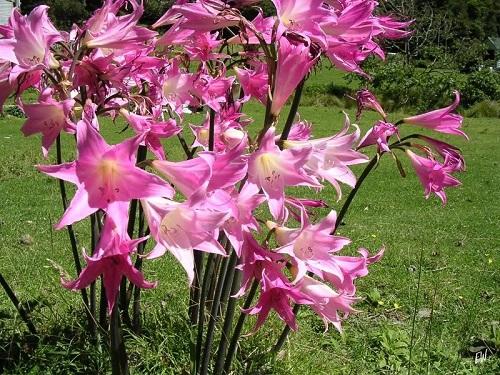
Landing
Prepare the soil before planting. The best soil for this is a 3/1 mixture of leafy soil and humus, or turf soil, overflow, humus and leafy soil in equal amounts.
Amaryllis bulbs should be planted in pots in the spring, after filling them with prepared soil. The volume of the pot must be chosen such that when planting from the flower bulb to the edge of the pot, there is no more than 2 cm.
It is necessary to transplant the plant into open ground in July, before the plant begins to actively grow and gain color. To do this, you need to dig holes no more than 15 cm deep, leaving a distance of 30 cm between the holes. Put the bulb 2/3 into the hole and sprinkle it with soil on top.
If a new baby has time to form, then it should be carefully separated.
Care
For better development, growth and flowering, it is necessary to maintain a temperature regime: during the day 20-22 ° C, at night 18 ° C.Watering should be moderate. It is better to water in the evening around the plant, avoiding getting water on the bulb. Amaryllis needs to be fed twice a month during the growing season. One top dressing should be complex mineral fertilizers, and the second organic.
Tip 2: How to care for amaryllis so that it blooms
Amarallis is a flowering perennial bulbous plant native to southern Africa. Grown as a pot culture
Flower care is simple, an important condition for flowering is a dormant period
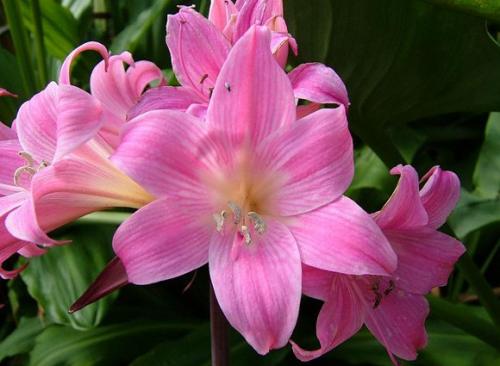
distillation of peduncles
Tip 3: How to transplant amaryllis
Amaryllis is a wonderful indoor plant with luxurious flowers of various colors. It blooms in winter, producing from one to three peduncles with several flowers on each. And it is better to transplant it in the spring, 4-5 weeks after flowering.
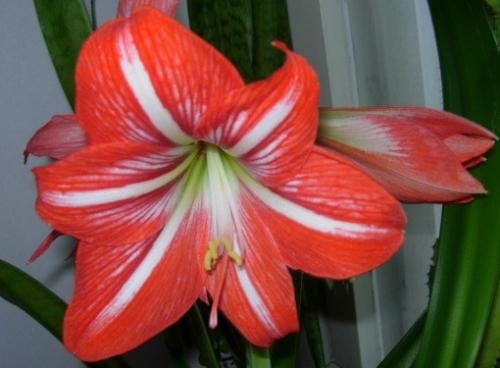
You will need
- - amaryllis 4-5 weeks after flowering;
- - a small pot;
- - substrate for amaryllis.
Instructions
1
It is advisable to replant amaryllis every year, maximum every two years. This is necessary to change the soil in the pots to a more nutritious one and to stimulate more lush and longer flowering. Amaryllis bulbs, especially during flowering, draw out all the nutrients from the soil. In turn, they try not for themselves, but for the peduncles. Therefore, all food is given to the flowers, and they themselves are depleted and after flowering decrease in size.
2
The secret of flowering amaryllis is a cramped pot. In a cramped dish, amaryllis bloom more willingly, while in a spacious pot you can not wait at all to bloom. After the amaryllis has faded, its peduncles are cut off (you can cut the flowers and put them in a vase at the beginning of flowering, then the bulb will not be so exhausted and this can stimulate the appearance of another peduncle). The amaryllis bulb is then removed from the soil. The roots are carefully examined. It is not necessary to cut off the root system of amaryllis during transplantation, but if you notice damaged, dried, rotted or diseased roots, they must be removed by sprinkling the sections with cinnamon powder or activated carbon.
3
Amaryllis bulbs often have babies, which need to be separated during transplantation and carefully transplanted into another pot for growing. You can plant the onion babies all together, tightly, in one pot, if there is no need to save the variety. They will bloom in the third year after separation. Therefore, after two years, they can be transplanted into individual small pots.
4
A pot for amaryllis is chosen such that its diameter is three times the diameter of the bulb (about 15-20 cm), and its depth is no more than 20-25 centimeters (depending on the size of the bulb). The pot must be heavy. A light plant with a peduncle released will definitely overturn. The planting tank is filled with well-drained soil rich in humus. It can be a purchased mixture for amaryllis and hippeastrum or its own, consisting of equal parts of turf, leaf, earth, humus and sand.
5
Be sure to put drainage on the bottom. It is good to pour (or put a stick) on the drainage layer of mineral fertilizers of prolonged action. The bulb is immersed in the substrate for 2/3 - 1/3 remains above the soil surface. The soil around the bulb is carefully compacted. After transplanting, the pot with the plant is watered with water at room temperature and placed on a bright window in a warm room.
Where to plant amaryllis garden
Its growth and development depends on the place of planting of amaryllis. Therefore, you need to responsibly approach this step, taking into account the preferences of the flower:
Choose an open place where there will be no obstacles to sunlight
His plant loves, so it is better to plant the bulb on the south side of the garden.
For amaryllis, the absence of drafts is important.
The soil must be well drained. Foam plastic, expanded clay, sand, perlite are used as an auxiliary material.
This will make the soil looser and more breathable. If there is a lot of clay, you need to add compost to it.

Amaryllis
Amaryllis in the open ground of central Russia will not be able to endure the winter. Therefore, before the onset of cold weather, the bulbs are dug up and sent to the premises for storage. Perennial wintering takes place in a pot, where it must be transplanted in advance. But you need to keep it cool, a comfortable temperature is in the range from 10 to 18 degrees. The main thing is that there is no minus in the room, otherwise the plant will die.
For amaryllis to rest and gain strength, 1-1.5 months is enough for him. At this time, you do not need to feed it, but it is slightly required to moisturize. It is very convenient to do this through a pallet. Be sure to pour out excess moisture to prevent decay.
Note! In southern countries with warm winters, the flower does not need to be dug out, but it is imperative to protect it from weather conditions. Peat, spruce branches and even sand are used as a covering material.
Amaryllis after flowering

Amaryllis has faded what next how to care after flowering photo
So, amaryllis has faded, what's next? The beginning of the dormant period is counted from the moment the last leaf of amaryllis falls and lasts at least two months, and sometimes it is better to increase the "rest" to three months.
- When the flowers wither, the amount of incoming water and fertilizers is sharply reduced. They completely stop watering and feeding the amaryllis when there are no peduncles or leaves left.
- All dead leaves are removed, but this should not be done forcibly. If a partially live leaf is left, it will still feed the plant.
- When the resting phase has finally begun, the pot is transferred into darkness. Remember that the roots are still alive, so the soil should be watered once a week with a spray bottle.
Another care option (but risky) is to scoop up the bulbs, peel them, and store them in cardboard boxes for storage. But you can disrupt some process and cause the roots to dry out.
Experienced flower growers know the tricks that make their amaryllis bloom twice a year - in early autumn and early spring. For this, a period of rest is strictly organized for the rest of the bulb and the accumulation of necessary nutrients. In January, they take out pots with amaryllis from the resting place, put them in a bright and warm place, and water them. Monitor soil moisture. All this stimulates a phase of rapid growth.
Reproduction
There are several ways to propagate this beautiful indoor flower:
- Getting young plants from seeds.
- Reproduction by daughter bulbs.
- Division of the uterine bulb.
Growing from seeds is mainly carried out by breeders who want to get unusual varietal combinations. This is a time consuming and painstaking method, as a rule, amateur flower growers do not use it. Particularly valuable bulbs are divided, which for some reason do not form children. However, most amaryllis easily produce daughter bulbs, which are easily detached and developed into full-fledged plants.
Daughter bulbs
What to do if child bulbs are needed, but they are not:
-
The uterine bulb is transplanted into a spacious pot. After 1–2 months, small processes form on the sides. By the end of the growing season, they will grow up and will be ready for transplanting. By the end of winter, when the leaves of the amaryllis begin to dry out, it is time for the children to separate. If the shoots are too small (less than 1–2 cm in diameter), the plant is sent into hibernation together with the children. In the second year, the bulbs will definitely grow to the desired size.
-
Amaryllis is removed from the pot, cleaned of scales, separating the largest children. Usually they already have their own roots. If the roots did not have time to form, that's okay. One plant can remove 1-3 babies suitable for independent growth. If you plan to bloom the uterine bulb, the remaining small processes are cut off and discarded.
-
Planting material is soaked in a dark purple solution of potassium permanganate for 2-3 hours, and then dried.
-
A nutritious light soil is prepared from sod, leafy soil, humus and sand in a ratio of 2: 2: 1: 2. A thick layer of drainage is laid at the bottom of the container, the soil is poured and lightly tamped.
-
The children are buried 2/3 into the ground, leaving the neck and part of the bulb above the ground. The pots are watered.
-
The first two years, young amaryllis do not require a dormant period, that is, they are grown like ordinary flowers, regularly watered and fed. Amaryllis, properly grown from babies, bloom in the third year.
Division of the uterine bulb
The method is based on the ability of a plant to form several points of growth from one bulb.
-
Choose a strong, healthy plant with a large bulb (at least 6-7 cm in diameter). Division begins when the amaryllis has faded, and the leaves have just begun to turn yellow. With a sharp knife, cut off all the foliage along with the root collar. At the same time, the bulb is not dug up, it is left to grow in the same place.
-
Cut the onion crosswise into 4 pieces. The cuts should be deep, to the very surface of the ground.
-
Wooden or metal knitting needles are inserted between the resulting segments so that the edges of the cuts do not touch. Instead of knitting needles, you can take thick nails, sushi sticks.
-
The divided amaryllis is left in the southeast or southwest window, shading from direct sunlight. Water it, trying not to get on the bulb, as the top layer of the soil dries up. The best temperature for the development of delenki is 25-28 degrees. After 1–2 months, a sprout appears in each segment. After a few months, daughter bulbs appear on each division. In the spring, the strongest babies are disconnected, and the uterine bulb is left to grow. In a few months she will give another portion of planting material.
- Daughter bulbs are planted in their own pots with the usual amaryllis soil mixture. Young plants do not need a dormant period. Flowering occurs at 2–3 years.
Diseases and pests of the amaryllis plant
Frequent diseases of amaryllis: fusarium, anthractosis, stagonosporosis
Like any plant, amaryllis suffers from parasites and diseases. Insects settle on both the ground and underground parts of the plant. The most common pests are:
- The amaryllis worm is a white, waxy insect that parasitizes under onion scales. Sooty fungi appear in the places of his excrement, which damage the bulb. A diseased plant loses leaves and slows down growth. To combat the worm, insecticides are used.
- The onion mite lives in the soil and damages the bulbs by gnawing into them. This leads to decay and the appearance of fusarium, and the plant itself looks depressed: the leaves turn yellow, the inflorescences become smaller. A favorable environment for the development of onion mites is high air temperature and high humidity.
- The mealybug is found on the leaves and stem as white fluffy spots. You can destroy the pest by wet wiping.
- If brown spots appear on the leaves, and insect scars appear on the flowers, it means that the amaryllis has been attacked by a false shield. You can fight it with soapy water or special insecticides.
Insect pests, in addition to mechanical damage to plant parts, are distributors and provocateurs of the occurrence of fungal diseases. Most often, amaryllis suffers from:
- fusarium (root rot).
- anthractosis (the appearance of dark spots and brown streaks on the leaves);
- stagonosporosis (reddening of the bulbs).
Treatment for fungal diseases includes isolating the plant, removing affected leaves, treating the bulbs with fungicides (Bordeaux mixture, Fundazol), and renewing the planting material.
What is the best way to care for a crossandra indoor flower at home.
How to grow a streptocarpus flower from seed? Be sure to read this material.
When can you transplant amaryllis at home? Amaralis flowers transplant planting
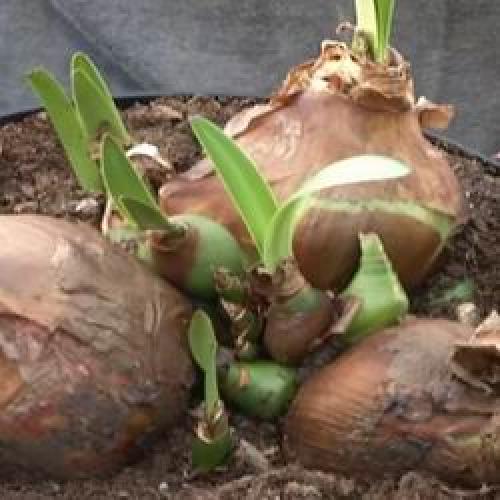
Amaryllis and onion babies, what to do after flowering
How to transplant amaryllis at home after flowering or after winter? The matter is not at all difficult, you just need to follow some rules and follow the advice of professionals whom you can trust. Next, you can find out a specific sequence of actions that can provide the most advantageous result.
- Bulb processing
- Pot for amaryllis
- Watching the dissolution
- After flowering
Bulb processing
Inspect your bulbs carefully at the beginning of planting. It is necessary to remove all dry and darkened layers, before the appearance of white tissues, this will give an influx of air, and will help to produce the necessary chlorophyll, which will give energy to stimulate the growth of a sleeping sample. Even there, invisible putrefactive foci may appear, diseases or young processes may appear. Lubricate the damaged areas with brilliant green, you can also apply Fitosporin. After cleaning, place the amaryllis bulbs in a suitable fungicide for half an hour, this can be saturated potassium permanganate or Bordeaux liquid. Then mandatory drying for about a day.
Pot for amaryllis
The most important thing is the correct pot. It should be quite heavy, stable, wide at the bottom, and slightly tapered at the top.
These precautions are necessary so that an accidental gust of breeze or a light hook does not turn your handsome man over. Naturally, use ceramic and unglazed, so it is easier to breathe and ventilate
Depending on the diameter of the onion, one or more pieces are planted, but at a distance of ten centimeters from each other.
The bottom of the container should have a large hole for drainage, drainage is immediately poured (expanded clay, small pebbles, pieces of shards) in sufficient volume, then a layer of sand, which serves as an additional guarantor against stagnation of excess liquid. Then fertilized soil, consisting of turf, humus and leafy soil, place your favorite fertilizer for flowering in it.
Land for amaryllis, must be selected correctly
- Turf
- Humus
- Leaf land
- fertilizer
And only after all the procedures, the bulb is placed with the blunt part down, it should be visible on the surface of the compacted soil mixture by one third. Planting Amaryllis belladonna ends with a place of residence, which should be noticeably warm and illuminated.
Watching the dissolution
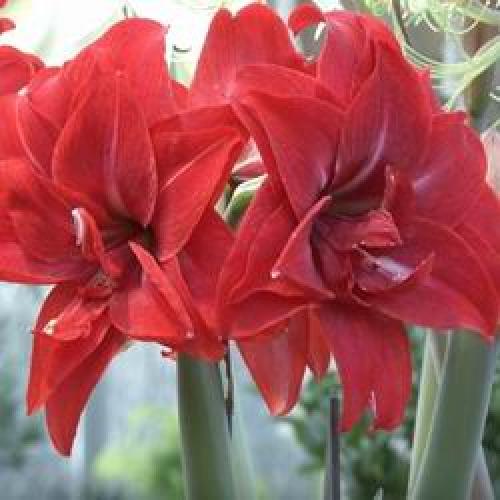
What is the flowering of amaryllis
The process from planting to the appearance of flowers in a strong and healthy bulb takes up to two months. And you can admire arrows with three or five gorgeous flowers. To bloom last as long as possible, place in a cool room and out of direct sunlight. The third peduncle, which may appear, will not please you, since you will break it off in order to avoid depletion of the bulb, the same is done with the second arrow if the bulb is small or weak.
Recommended. After the first bud opens, cut the arrow and place it in a narrow elegant vase, changing the water daily. The next buds will bloom in almost the same way, both in a vase and in a pot, only in this way you protect your onion from unnecessary exhaustion.
After flowering
Surely, many of you, admiring the beautiful and exotic flowers, do not think about the future fate of your pet, but the time comes when the amaryllis has faded, what to do next you have no idea, and, precisely, now the advice of experts will be just as timely. After the end of flowering or cutting off the peduncles by you, the abundant watering is stopped and replaced with the one that was discussed a little higher
You do not need to cut the leaves yourself, because through them all the accumulated nutrients will pass into the onion, which is very important for subsequent development. We transfer the pot to a darkened place with a low temperature of + 10 ° C (minimum)
The dormant streak should last three to four months, otherwise Amaryllis will not be able to accumulate strength for subsequent development and may die after a while.
Flower history and appearance description
The name of the flower amaryllis in translation "beautiful" is mentioned in history by Carl Linnaeus, who described the wonderful flower gardens of Amsterdam in 1753. Further, amaryllis became widespread in Europe, from where it was brought from Africa, and for three centuries in a row its popularity has not subsided.
The plant of the genus Amaryllis is a perennial. It is a bulbous flower with long, straight leaves reaching 60 cm in length and up to 3 cm in width. Amaryllis leaves are located one above the other. The bulbs are oblong in shape, resembling a pear, the length of the bulb is 10-12 cm.
Amaryllis bulbs can give 1-2 stems, on which later large inflorescences of bell-shaped flowers arise. The shades of the peduncles are very diverse: bright red, purple, pinkish, beige. The flower in its open state reaches a size of up to 8 cm. The petals are semicircular, with sharp ends, in the amount of 6 pieces.
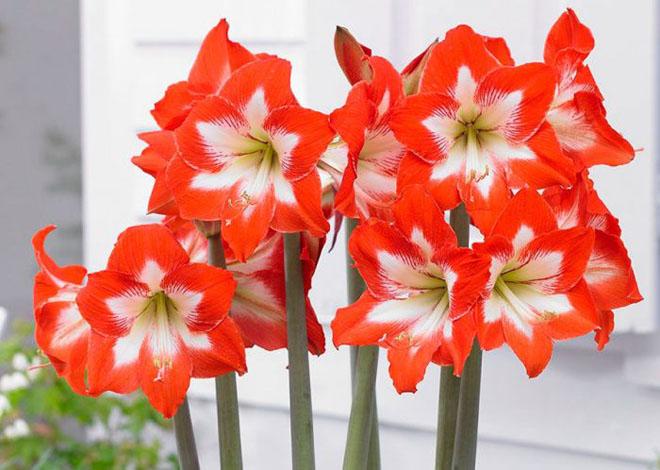
Popular amaryllis varieties
Flower breeders are actively developing the amaryllis species and developing or improving new varieties and palettes. The most popular amaryllis varieties today are:
- Terry amaryllis - known for their large inflorescences: DOUBLE DRAGON, DOUBLE ROMA. Also among the most popular flowers with enlarged buds are: BLACK PEARL, WHITE BABY, MOON LIGHT and others.
- Amaryllis with unusual shades: TEMPTATIA, CLOWN, PIZAZZU and others.
- Amaryllis with a unique flower shape, another name for breeders "spiders": SPOTTY, LIMA, GRANDEUR and others. The disadvantage of these species is that, due to the changed shapes of the petals, the bud itself is several times smaller than its brothers, but florists love spiders for their extraordinary appearance in compositions.
Below are photos of amaryllis.
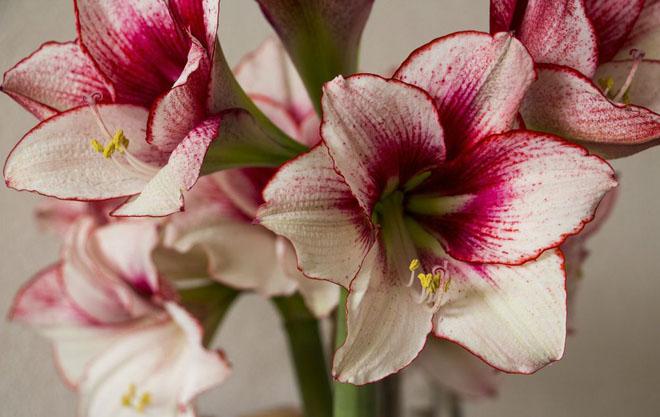
About caring for Amaryllis:

Temperature: The optimum temperature for amaryllis in summer is 18-25 ºC, while in winter the temperature should not drop below 10 ºC. Amaryllis is a thermophilic plant, but it is not recommended to place the plant next to batteries or heaters in winter. In summer, the plant can suffer from the cold air currents of the air conditioner, so it should not be placed in critical proximity to them. The plant needs to provide a decrease in the night temperature compared to the daytime. In summer, Amaryllis can be taken out onto a balcony or terrace, while protecting it from direct sunlight, wind and precipitation.
Lighting: Amaryllis needs bright lighting and a southeast and southwest window sill works well for it. The plant only needs shading in the summer in noon and immediately after transplant or landing. In winter, it is not worth shading. The plant must be regularly rotated in order for the leaves to develop evenly.
Watering: For Amaryllis, watering should be regular sweat as needed. The substrate of the plant should have time to dry out slightly between waterings. It is necessary to water it with warm soft settled water, trying to prevent the ode from getting on the bulb. After watering, the water from the pallet must be drained.
Air humidity: Amaryllis is picky about air humidity. For him, the daily procedure should be spraying the leaves of the plant with soft, settled water in the morning and in the evening, especially if the plant is kept in a room with dry air. Regular spraying will preserve the decorative effect and improve the well-being of the plant. In order to increase the humidity, pallets with wet expanded clay can be used. In this case, the bottom of the amaryllis pot should not touch the water. It is necessary to clean the leaves from dust.
Fertilizers: It is necessary to fertilize Amarallis in spring and summer once every 2 weeks, since there are few nutrients in the stony soil, and frequent watering does not allow them to accumulate.Fertilizers must be applied through the pallet, immersing the plant in a container with fertilizer for 20 minutes, and then allowing the excess to drain. Further, for feeding, complex fertilizers are used for decorative deciduous plants.

Soil: For Amaryllis, the soil must be nutritious and well-drained. For him, they take a universal substrate or soil for decorative deciduous plants, to which charcoal, coconut soil, sphagnum moss, perlite and humus are added to increase nutritional value. Good drainage is required at the bottom of the pot.
Transfer: Amaryllis is rarely transplanted, only as needed, in the middle of summer. The pot is selected not wide, but deep (the bulb has a long root system), making sure that the distance between the bulb and the wall of the pot does not exceed 3 cm.The bulb is buried only halfway keeping the leaves, which serve as a source of nutrition at first, until roots are formed (1.5 months). In a cramped pot, the plant blooms faster, but if you want to achieve the appearance of daughter bulbs, then the pot must be taken wider.
Pests of Amarallis. Damaged by spider mites, thrips, mealybugs, slugs.
Amaryllis: Photo and general description
The amaryllis flower is very often confused with hippeastrum. This is quite logical, these two varieties are bulbous, have beautiful flowers on a high peduncle, belt-like, long leaves. But there are very significant differences in these plants, which belong to the amarylissa variety:
- Peduncles in hippeastrum are hollow inside and fragile, in amaryllis they are strong and dense.
- Amaryllis has a delicate and delicate aroma; hippeastrum flowers have no odor.
- Flowers in hippeastrum in some cases in diameter can reach 15 cm, in amaryllis flowers are much smaller, only up to 7 cm, but there can be up to 12 of them on the peduncle.
- Hippeastrum blooms at first, then forms leaves, amaryllis begins to bloom with leaves.
- Hippeastrum is a native of the tropics of South America, amaryllis was brought from South Africa.
- Amaryllis has only one variety, the hippeastrum has more than a hundred of these varieties.
As a rule, hippeastrum is most often offered in flower shops, when you decide to have amaryllis at home and not be mistaken, then you need to choose a flowering plant, because, thus, it is easier to decide at least by aroma.
Diseases and pests
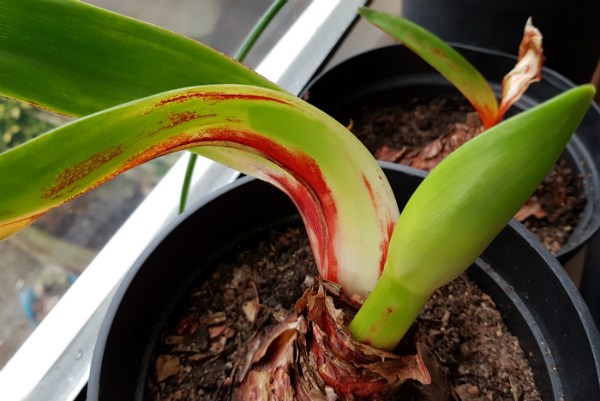 The flower is attacked by pathogenic organisms that lead to the development of rot. The reason is the violation of the maintenance regulations: excessive watering, high concentration of nitrogen-containing fertilizers in the substrate. With the intensive development of the disease, the plant may die. To prevent this, it is necessary to protect it in a timely manner.
The flower is attacked by pathogenic organisms that lead to the development of rot. The reason is the violation of the maintenance regulations: excessive watering, high concentration of nitrogen-containing fertilizers in the substrate. With the intensive development of the disease, the plant may die. To prevent this, it is necessary to protect it in a timely manner.
Among the pests that feed on the shoots of amaryllis, spider mites, mealybugs and scale insects are distinguished. They should be dealt with by spraying the plant with insecticidal preparations according to the instructions on the package. Processing is carried out in the fresh air, having previously covered an earthen lump with cellophane.
Amaryllis, the care of which consists of standard activities, is one of the beautifully and profusely blooming indoor flowers. Spending very little time, it is easy to refresh the interior of an apartment or office with it.
Planting requirements: an important condition for flowering
It is possible to achieve that the amaryllis blooms, subject to the rules of planting and caring for the plant. A native of Africa, in foreign latitudes, he requires the help of a florist in order to release a peduncle and dissolve a beautiful bud. Conditions for flowering should be created in advance, even before the arrow appears from the bulb.
The first important requirement on which the future flowering of amaryllis depends is the correct planting of the bulb. For this:
Correct planting of the bulb plays a very important role in the future growth of the plant.
- Choose healthy bulbs with a diameter of about 7-10 cm.
- Dried and decaying roots at the bottom of the bulb are removed.
- A drainage layer is arranged in the pot - expanded clay, gravel, on which a complex fertilizer of prolonged action is placed.
- The container is filled with humus-rich soil - a mixture of sod and leafy soil with humus and sand is suitable.
- The planting material is freed from dry outer scales and babies that have made their way to the surface - they can cause a delay and even a lack of flowering.
- The bulb is planted with a blunt end in the ground and buried 2/3 of the height.
- The soil mixture is compacted around the bulb.
The answer to the question of why amaryllis does not bloom can be the pot in which the planting is performed. It should be heavy enough not to tip over under the weight of the plant during flowering. Due to the rather high windage of the leaves, a strong gust of wind can also turn over the amaryllis. Of the materials, ventilated ceramics without enamel are preferred: in such an environment, aeration of the root system is better.
The ideal choice would be a pot that is no more than 5 cm in diameter than the cut of the bulb. The size is selected so that a finger can enter the ground from the edge of the bulb to the side of the pot.
In a more spacious pot, new babies appear more intensively, and in a cramped space, the exotic blooms more likely.
However, the container must be deep enough so as not to interfere with root development.
Alternatively, the plants can be grown in groups in a container. Then, when planting, a distance of 10 cm is measured between the bulbs. With proper care, after planting, amaryllis blooms for 4 years.

